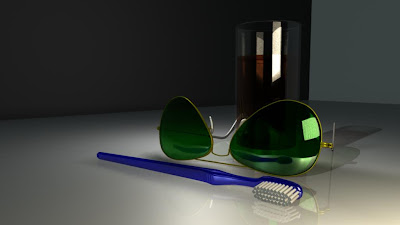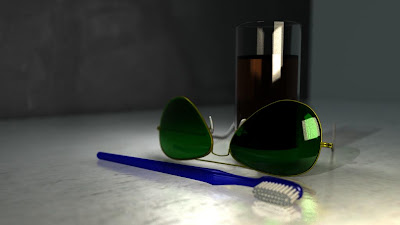I have been learning a bit about mental ray and glass. During the domino effect project I know a lot of people spent some time trying to create the best looking glass effect. So far here is the best way of doing it. This render is done using mental ray (although surprisingly the render time was not too high and with the method I used you can be fairly flexible and trade small details for faster render quite easily). The beauty of the method for making glass I was using is it just uses blinns and phongs, no antisoptic materials or mia materials. It just becomes a case of altering the eccentricity to achieve the correct shape of highlights and using transparant colour to make the material transparant in a realistic way rather than just turning opaque. Then once you turn on raytracing and raytrace shadows you can start to adjust refractions when light is travelling through glass. Finally I used the hypershade to create something known as the fresnal effect within my glass and water giving even more realistic reflections and refractions.

Between these two renders I was making the floor a glossy surface so I had to spend some time trying to make the reflection appear in the floor but to be sharper closer to the object and blur further away, but without just being a poor qualitly.


Finally I added textures (colour, bump and specular to the floor) and just colour to the feature wall. Then it was time to add one of the biggest realism factors of all (although it adds a fair bit to rendering time it was well worth it). I am of course talking about the depth of field on the camera, I used a locator and set it on the front corner of the glasses cause the image to go out of focus slowly from that point onwards.


 Finally I added textures (colour, bump and specular to the floor) and just colour to the feature wall. Then it was time to add one of the biggest realism factors of all (although it adds a fair bit to rendering time it was well worth it). I am of course talking about the depth of field on the camera, I used a locator and set it on the front corner of the glasses cause the image to go out of focus slowly from that point onwards.
Finally I added textures (colour, bump and specular to the floor) and just colour to the feature wall. Then it was time to add one of the biggest realism factors of all (although it adds a fair bit to rendering time it was well worth it). I am of course talking about the depth of field on the camera, I used a locator and set it on the front corner of the glasses cause the image to go out of focus slowly from that point onwards.
No comments:
Post a Comment